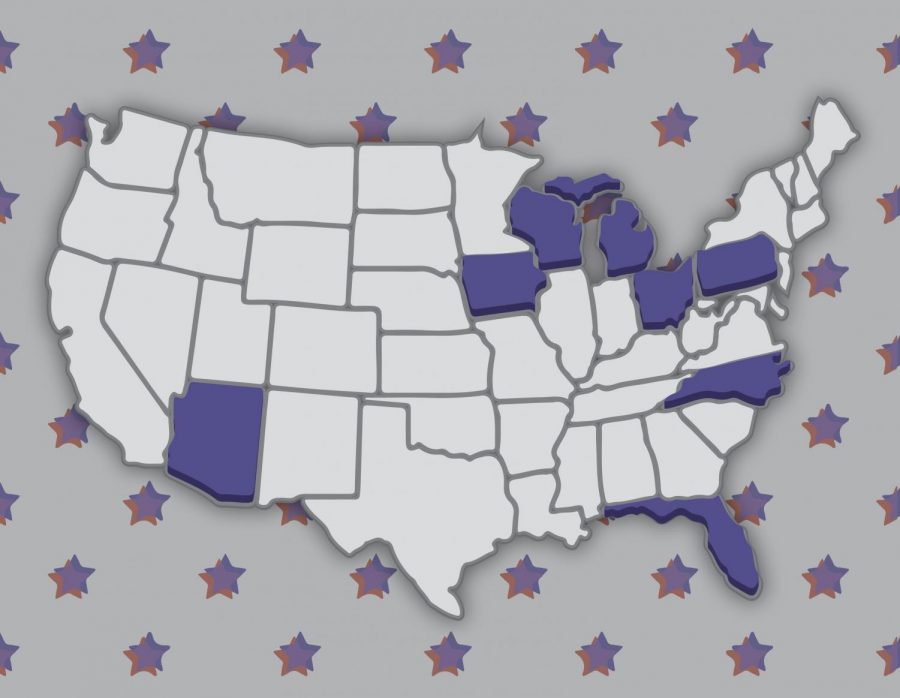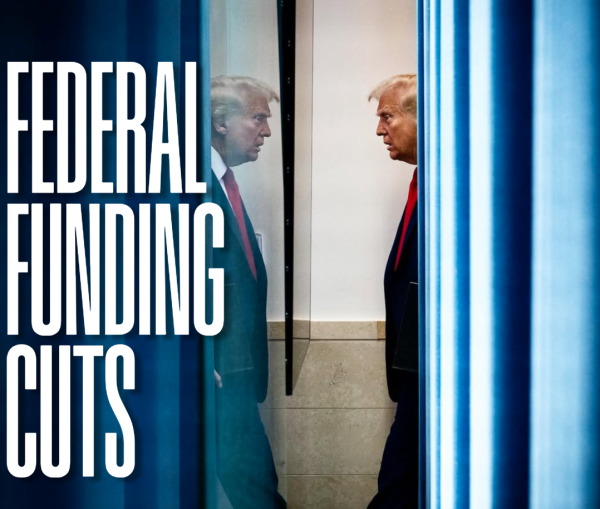Swing State Polls Are No Guarantee
The signs of autumn have speedily encroached upon us, with leaves fading to brown, temperatures dropping and Halloween quickly approaching.
Anticipation across America is building as Nov. 3 threatens to rear its ominous head, so it’s no wonder that voters are eager to get an inside scoop on what is to come. The best, or really, the only way to do this is through the time-honored tradition of polls. However, as proven by the 2016 election, general polls aren’t the most reliable source, seeing as Hillary Clinton was notably leading in a majority of the polls against Donald Trump. Since the presidential win relies on a majority of electoral votes and not simply a majority of popular vote, a closer look at this year’s swing states provides more accurate insights into the upcoming election’s outcome.
Swing states, or states that are not more likely to lean Democratic or Republican based on recent history, are integral to a presidential win. They remain more of a mystery, and their undecided nature makes them a target for presidential campaigns. Most other states are notable for voting amongst partisan lines. New York, for example, is well-known for reigning blue. Most Democratic candidates are safe in presuming that New York is a near guaranteed win, since New York has not voted red since the days of Ronald Reagan in 1984. Nonetheless, Trump alluded to an attempt to win the state earlier in the year, saying he was “going to try very hard to win New York” and citing violence in New York City as a reason for state voters to turn against his opponent, former Vice President Joe Biden.
This year, the Guardian tracked polling in eight specific states identified as this year’s swing states. The eight identified swing states are Arizona, Florida, Iowa, Michigan, North Carolina, Ohio, Pennsylvania and Wisconsin. Most of these states were selected because they flipped from voting blue in support of Barack Obama in 2012 to voting red for Trump in the 2016 election. Two of these states — Arizona and North Carolina — were added because while they are well-known for leaning red, polls have hinted that the states may flip blue in favor of Biden. Polls show six of these eight states currently presenting a lead for Biden. Florida, a coveted win for its whopping 29 electoral votes, shows Biden with a 1.7% lead against Trump. This would be a notable win, not only lending a hefty amount of electoral votes to Biden, but also further denoting Florida as a “flip-flopping” state, having voted blue in 2012 and then red in 2016.
Michigan is another significant state, forecasting a win for Biden in the polls, who is currently beating Trump by 7.4%. This is the highest percentage lead shown amongst all eight swing states. Although not as formidable a force as Florida, Michigan still holds a noteworthy 16 electoral votes. Formerly a well-known blue state, Michigan would be a sweet victory for Biden after flipping red in support of Trump in 2016.
Ohio and Iowa are the only two swing states leaning red in recent polls, although by noticeably smaller margins than the states swinging blue in support of Biden. Ohio— holding 18 electoral votes— shows Trump leading by 1.8%, while Iowa—with 6 electoral votes—shows Trump leading by a mere 0.1%. Both Ohio and Iowa voted for Barack Obama in 2008 and 2012 yet flipped to vote for Trump last election, making them especially difficult to predict.
The qualifications of what makes a swing state, though, are completely up to interpretation. Politico, for example, has a slightly different list of swing states for this year’s election. After excluding Ohio and Iowa, Politico presents a list of the same remaining six states along with Georgia and Minnesota. Georgia presents itself as a bigger win with 16 electoral votes. After voting red in the last election, polls show Georgia leaning red once more, although by a much smaller margin than it did in 2016. Minnesota, with 10 electoral votes, voted blue in support of Clinton in 2016, and shows signs of voting blue once more. However, polls show Biden leading in Minnesota by a much larger margin than Clinton cinched in 2016.
Although these swing state polls give voters a much more accurate look at electoral predictions than general polls do, the same question persists: Are these polls even worth looking at? Hillary Clinton was beating Donald Trump in nearly every poll in 2016. Democrats across the country believed she was a shoo-in. Political commentators were confident in this; it was taken as near fact. The thought of Trump winning the presidency was even laughable to many.
In recent years, polls seem to have become less and less trustworthy, despite desperate assurances from pollmakers. This is probably due to the increasingly divided political nature of America. Whether or not you support Trump, it is easy to see why plenty of Trump’s voters would not want to voice their support for the president in polls: A strong stigma surrounding Trump supporters has developed. The issue goes both ways; in today’s aggressive political climate, it makes sense that voters would not want to voice their honest opinion in fear of those in their lives who lean the other way. Voters in both arenas fear being attacked for their political opinions, a notion that sounds ridiculous written on paper but has become widely accepted as an unfortunate reality.
The polls are certainly interesting to look at, and they help provide insight into swing state voter trends. However, the only fact that remains clear is that voters won’t feel confident in assessing a winner until the votes are counted on Election Day. Even then, I’m sure most won’t feel confident in the winner. One way or another, Nov. 3 is sure to prove a day for the history books.
Taylor Herzlich, FCRH ’23, is a journalism major from Mt. Sinai, N.Y.

Taylor Herzlich is a senior at Fordham College at Rose Hill. She is majoring in journalism with a minor in English. Taylor started writing for the Ram...










































































































































































































